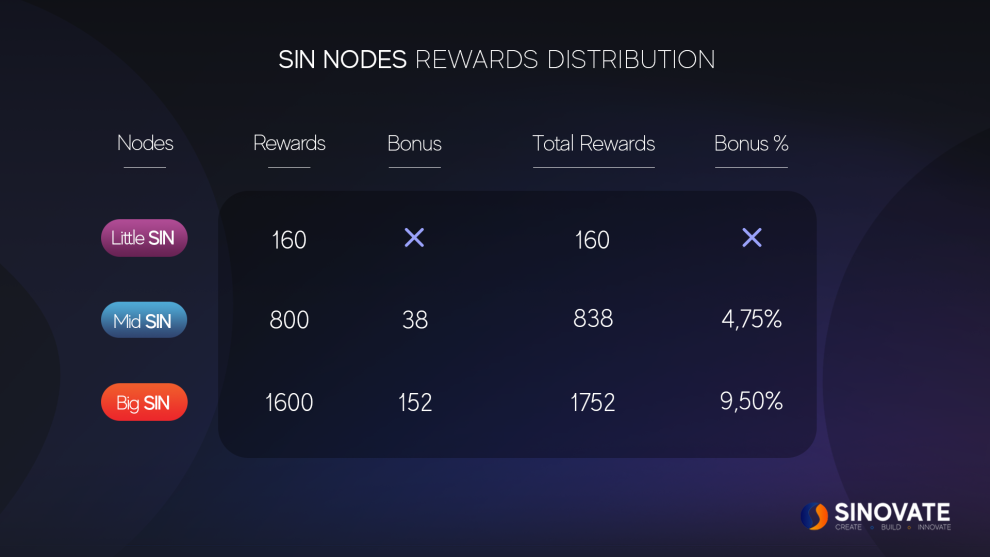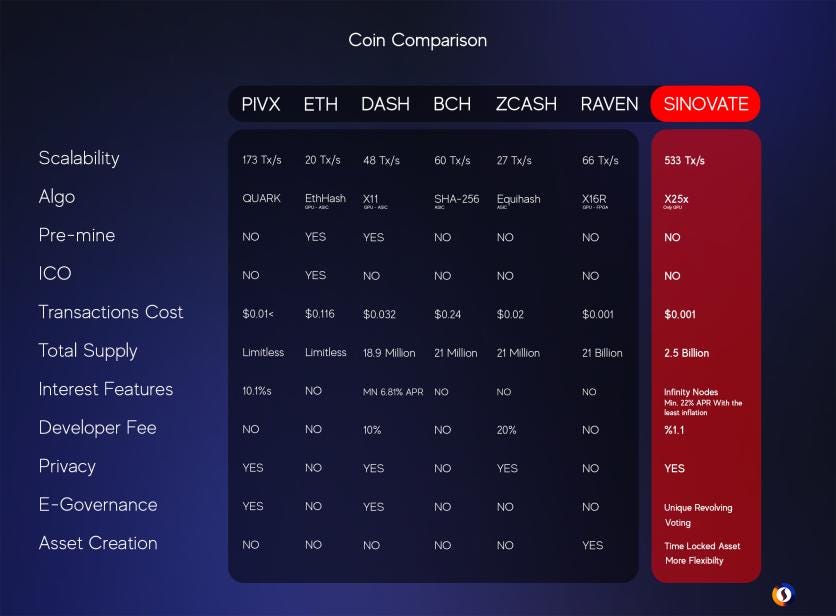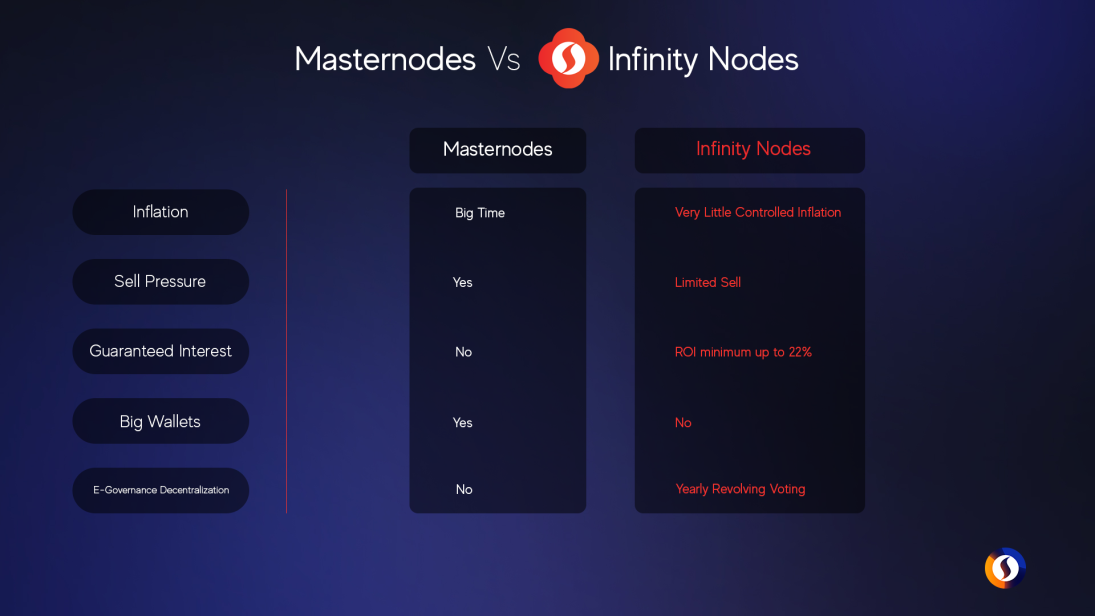What is a Masternode and how does SINOVATE apply this technology in a innovative way with its Infinity Nodes?
1. What is a blockchain and a node?
A blockchain is a continuous growing decentralized ledger containing records, in the crypto currency world called blocks, linked together using cryptography. Each block contains a cryptographic hash of the previous block, a timestamp and transaction data, represented as a Merkle tree. This hash trees concept was patented in 1979 and named after its inventor: Ralph Merkle. A hash tree is a tree of hashes and nodes further up the tree are the hashes of their respective children. For example: in the picture hash 1 is the result of hashing the chronological sequence of hash 1–0 and hash 1–1. Hash trees are used in hash-based cryptography, but also in IPFS, Btrfs and ZFS file systems to counter data degradation. Other usecases are Dat protocol, Apache Wave protocol, Git and Mercurial distributed revision control systems, the Tahoe-LAFS backup system, Zeronet, the Certificate Transparency framework, a number of NoSQL systems such as Apache Cassandra, Riak and Dynamo, and last but not least the Bitcoin and Ethereum peer-to-peer networks.

A node is simply a copy of a blockchain ledger. People rely on nodes to keep track of the cryptocurrency transactions that have occurred on the blockchain. The nodes share blocks and transactions with each other using the underlying protocol. When a miner creates a valid new block, he shares it with the rest of the network and each node propagates it further to the other nodes. Not all the nodes in a network store the whole blockchain’s blocks and transaction history. Every person can decide to create a node, but because a full node stores the complete blockchain transaction history, this requires a lot of computer memory. Because of the amount of computer memory required, there are two types of nodes: full nodes and light nodes.
Full Node vs Light Node: A full node stores the complete list of blocks and transactions that occured on the blockchain, a light node only stores a record of the more recent transactions, for example during the last three weeks. Even though the light node only stores a partial list of transactions, it still plays an important role as it is linked to full nodes to help keep the blockchain accurate. A light node can store a subset of data, for example the block headers, they can then rely on full nodes for the other information.
2. What is a MasterNode?
Without nodes, a blockchain can not function. A masternode is a special full node: it typically processes transactions that occur on the blockchain, 24/7. To continuously process transactions, a masternode requires a lot of computer memory and a collateral. The memory is simply computing power, the collateral is the amount of coins required to run the masternode. To run a masternode, most people turn to a vps server, to set up a dedicated IP-address.
A VPS, also known as a Virtual Private Server is a virtual machine provided by a web hosting company and runs on its own operating system (OS). It provides admin rights and root access to clients who can install almost any required software, for example a masternode.
A dedicated IP address is a unique Internet Protocol (IP) address and is assigned exclusively to a single hosting account. It offers you access to your website even when the DNS is not setup, it provides increased speed during high traffic load and brings increased security.
3. What is a SINOVATE Infinity Node?

Where as SINOVATE miners create blocks and the primary infrastructure layer, SINOVATE Infinity Nodes don’t create blocks but do allow for implementation of important secondary services like SINOVATE FlashSend and ShadowSend, which are evolved from InstantSend and PrivateSend.
SINOVATE has developed a blockchain that is globally dispersed with Multi-Tiered Masternodes that create different user entry levels to enable more investors to obtain a SIN Masternode, called an Infinity Node. This approach also benefits Sinovates decentralisation goals, which are often problematic in crypto projects with single tier masternodes.
A Little SIN NODE requires 100,000 SIN, and has Base Block Reward of 160 SIN;
A Mid SIN NODE requires 500,000 SIN and has a Base Block Reward of 800 SIN and a Bonus of 4.75% (+38 SIN), with a total reward of 838 SIN;
A Big SIN NODE requires 1,000,000 SIN and has a Base Block Reward of 1600 SIN and a bonus of 9.50% (+152 SIN), with a total reward of 1752 SIN.

Both Little, Mid and Big SIN are full nodes, they all contribute in a different manner to the SINOVATE Blockchain. Both Little and Mid Sin offer services like IDS, Flashsend and Shadowsend, the Big Sin offers RSV on top of those services. The only way to acquire a SIN Masternode is by acquiring SIN from mining, trading or earning.
The first crypto currency to adopt masternode technology was Dash. Dash paved the way for masternodes, developing distinctive incentives for masternode service providers. The collateral is 1,000 Dash, the block reward 45%. Soon after other projects were launched. PIVX for example offers masternodes but is Proof of Stake (PoS) as well. In the comparison table we can see the differences between the crypto currency projects described and what makes SINOVATE groundbreaking.

SINOVATE is the top Masternode Coin when it comes to scalability, it is therefore best positioned to profit from the next crypto currency market expansion phase. There was no ICO and no premine, the project was fully funded by the developers. Due to many scams in the cryptosphere, many investors aren’t willing to invest in premined coins, nor do they still have any trust in ICO projects. It is predictable that IEO’s will suffer a similar fate as the ICO’s did during their initial hype.
SINOVATE realizes that a crypto currency project’s value comes from hard work and innovative approaches and has therefore created an international team of experienced developers to support such an undertaking.
SINOVATE controls inflation with an actively monitored inflation rate on a yearly basis and offers its investors, users and community both Privacy and E-Governance, using its uniquely developed Revolving Voting System.
MASTERNODES vs INFINITY NODES
Compared to traditional Masternodes, SINOVATE Infinity Nodes offer investors better protection against inflation with a very little controlled inflation or less added coins from the MAX Supply depending on the burnt coins. There is less sell pressure compared to other masternode coins and SINOVATE offers a minimum up to 22% interest rate. Last but not least, the SINOVATE project is governed using Yearly Revolving Voting, a further developed decentralized governance blockchain feature.

WebsiteDiscord . Telegram . Bitcointalk .Twitter .Facebook .Linkedin.Team.YouTube.Reddit.
CryptoAnalyzer
Original article https://medium.com on June 22, 2019.
Recent Comments